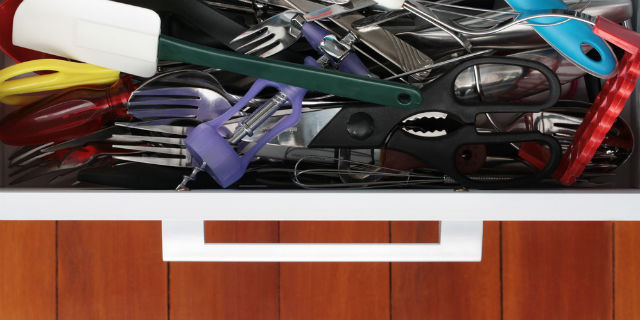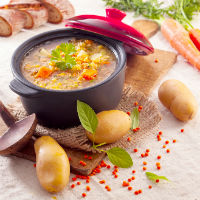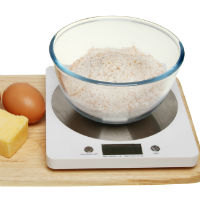If your kitchen drawers and cabinets are anything like mine, one of their primary functions is to conceal an embarrassing number of unnecessary gadgets. A quick survey of my kitchen reveals a nine-piece Messermeister garnishing tool set my husband bought three years ago… and hasn’t used once; ice cream and melon baller scoops in four different sizes (and various states of disrepair); six different sizes of sieves (three mesh; three metal); two Amco lime and lemon squeezers, and a quantity of serving cutlery, mixing spoons, tongs, and Microplane graters that would require shutting down our kitchen for at least three days in order to inventory properly.
To be fair, not all of these gadgets are purchases we’ve made. My husband, who once worked as a private chef and cooks at least two meals a day at home, has received many of them as gifts. But we’re as guilty as you probably are of buying lots of kitchenware we don’t really need.
If we were to strip our kitchen down to the bare essentials, which would probably be a good project to take on, there are seven gadgets with which we’d refuse to part, besides our set of good Wusthof knives, cast-iron skillets, and copper-bottom pans. And though I don’t advocate cluttering your kitchen even more, these are seven pieces of not-so-obvious kitchen gear that every serious home cook should consider acquiring because they are versatile and simple workhorses that get the job done.
Clay Pot
We acquired our first clay pot while living in Mexico; seven years after we bought it at our local market, it still serves a remarkable number of purposes. The original Crock-Pot (and far more versatile than that plug-in-the-wall invention), clay pot cooking has long been used in many parts of the world–from Morocco to India and Germany to Vietnam. You can cook almost anything in a clay pot–beans, rice, and even bread–but it’s especially effective for cooking meat, particularly if you’re someone who is worried about overcooking or undercooking beef, pork, and poultry. The clay pot circulates moisture continuously while in the oven or on the stovetop, preventing meat from drying out, and it’s far more forgiving than other cookware if you leave the pot in the oven longer than intended.
Like a cast-iron skillet, clay pots need to be cured and maintained properly for best results. Don’t take your clay pot out of the oven and immerse it in water; it will crack. When it has cooled down, fill it with lukewarm water; add baking soda or vinegar and let it soak for an hour before rinsing it and rubbing it gently with a dry cloth. You don’t want to use abrasives or hard dish soaps, as these leach into the pores of the clay and will change the flavor of future meals cooked in the pot.
Two sturdy whisks
I burned out our electric mixer over a year ago and just haven’t gotten around to replacing it. In a way, I’ve been challenging myself to find a recipe that requires a handheld electric mixer, but so far, I’ve learned that nearly everything can be mixed by hand if you have a little bit of patience. Plus, electric mixers take up far too much space. If you’re adamant about needing an electric mixer, invest in a quality make and model; the cheap grocery and department store versions give out much too quickly if you’re a regular baker or cook. Otherwise, two sturdy whisks will do just fine. Buy one larger balloon whisk—12-inches–for mixing batters and doughs, and a smaller egg whisk—6.5-7 inches—for eggs, homemade salad dressings, and other thin mixes.
Click on to discover our next 5 picks for Latin kitchen must-haves!…
[pagebreak]Bamboo steamer
Yes, it originated in Asia, but a bamboo steamer definitely has a place in the Latin kitchen, too. Line the steamer (which you can buy at any Asian food supply or home goods store or online through; sizes range from 6-inches to 12-inches) with slices of grapefruit, orange, lemon, or lime and steam fish or chicken on top of these. Add some sprigs of fresh rosemary or other herbs (cilantro and culantro are excellent choices), too; the fish or chicken will cook quickly, absorbing the flavors of the citrus and herbs.
Bamboo steamers are a great way to start transitioning away from frying toward healthier preparations. And you can use them for vegetables, too, so they’re quite versatile. They’re easy to clean and store and last longer than you might think if cared for properly.
Mortar and pestle
Forget the electric spice grinder (yes, I do have one, but it sits on the top of my refrigerator, where I forget about its existence and never use it); the good old-fashioned mortar and pestle is where it’s at. From mashing garlic for mojos and sofritos to grinding spices down to a fine powder, the mortar and pestle can do almost anything if you give the task time. Plus, it cleans much more easily than an electric spice grinder. As with the clay pot, don’t use harsh abrasives or soap to clean the mortar and pestle. Let it soak in a lukewarm solution with baking soda or vinegar.
Digital scale
If you enjoy baking regularly, you may wonder why the result is never quite the same when you use the same recipe time after time. The answer can probably be traced to the weight of your dry ingredients, especially flour. One cup of flour measured out today probably isn’t the same measure tomorrow, even if it looks the same. A digital scale can be really useful in improving the accuracy of your dry ingredient measures, ensuring a more consistent result.
One good measuring cup
For all the clutter in your cabinets and drawers, I’ll bet you have a tool or gadget that you can never find when you need it. For me, that’s the other seven measuring cups that accompany the apparent sole survivor of our set of eight measuring cups. But I’ve learned that, as with the whisk, I can get by with my one-cup measure in any recipe because it is marked with intermediate measures on the inside. A single quality measuring cup will do just fine in most situations. (The same is not true, however, for measuring spoons, so invest in a good stainless steel set).
An old-fashioned juicer
That handheld Amco lime juicer is adequate, and as far as gadgets go, it doesn’t take up a ridiculous amount of space, but we recently bought an old-fashioned juicer— the kind where you put half of your lime, lemon, or orange on a cone-shaped tip and twist back and forth to extract the juice–and I like it much better. One of the reasons is because it does a nice job of keeping the peel intact if I want to use it for something else: cocktail garnishes, candied citrus peel, zest, or lining the bottom of that bamboo basket.




![Making Mealtime Matter with La Familia: Easy Sofrito [Video]](https://thelatinkitchen.com/wp-content/uploads/2015/10/sofrito-shutterstock__0-500x383.jpg)
![Easy Latin Smoothies: Goji Berry Smoothie [Video]](https://thelatinkitchen.com/wp-content/uploads/2015/12/goji_berry-shutterstock_-500x383.jpg)
















![Fun and Fast Recipes: Fiesta Cabbage Salad [Video]](https://thelatinkitchen.com/wp-content/uploads/2015/11/fiesta_cabbage_slaw-shutterstock_-500x383.jpg)









